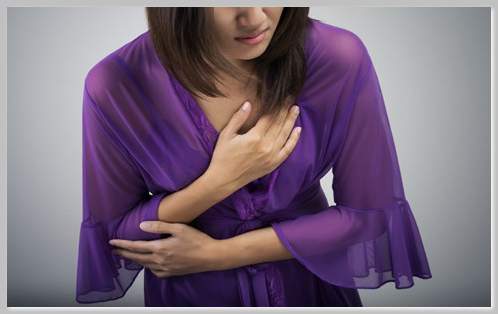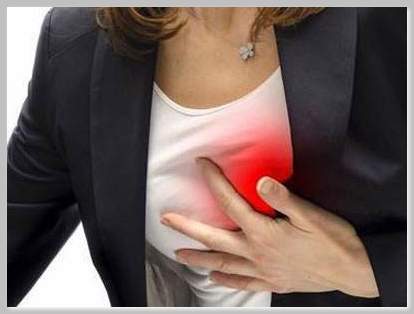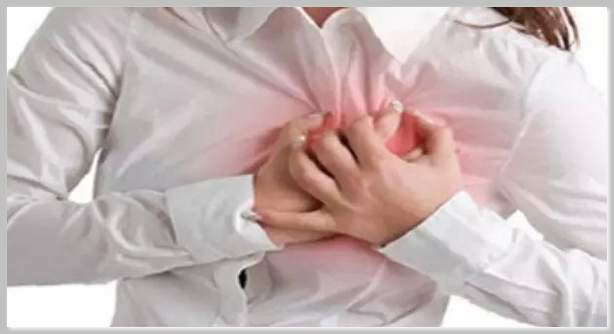
Feeling pain in any part of the body can cause an alarm because it is the body’s way of informing us that something is wrong. However, before you start to panic, it is best to understand the various reasons behind this discomfort. When a person has pain under the left breast, it can be due to a problem in one of the organs in the upper left region of the body, which includes the heart, lungs, ribs, stomach, and colon.
What Causes Pain under Left Breast?

Someone may experience left side pain below their breast due to several reasons including the following:
Chest and Heart Problems:
- Chest Wall Injuries
Typically, a person will feel a sharp chest pain because of an injury as a result of an accident, or if you have unknowingly hit this body part. However, heart and other internal problems can also cause a chest pain. For this, it is essential to observe, look for other symptoms, and consult your doctor, especially if the pain is persistent.
- Angina
A common symptom of heart problems is angina that occurs when the supply of oxygenated blood to the heart muscle is not enough.
Coronary artery disease is a medical condition that causes angina because of the build-up of plaques in the arterial walls. Other risk factors of angina are high blood pressure, high cholesterol levels, obesity, alcohol abuse, and smoking.
A person suffering from angina will feel tightness in his chest along with pain under left breast, which may spread towards the back, shoulder, neck, or jaw.
- Pericarditis
Surrounding the heart is a thin membrane known as the pericardium. Pericarditis happens when there is inflammation in this membrane because of a respiratory infection. One may also develop pericarditis due to autoimmune diseases such as lupus, rheumatoid arthritis, and scleroderma. Other possible causes are heart surgery, kidney failure, accidents, and certain medications.
Patients with pericarditis will experience an intense pain in the chest, shoulder, or neck. The pain may get worse when lying down, inhaling, and coughing. Other symptoms may include fever, fatigue, shortness of breath, heart palpitations, and leg or abdominal swelling.
- Precordial Catch Syndrome (PCS)
PCS is not a life-threatening condition. However, it will cause a sharp, stabbing chest pain that gets worse when a person inhales. This ache can last for a few seconds to 30 minutes.
A person may experience PCS when the nerves located in the chest are squeezed. Most patients describe this condition as a bubbling feeling in the chest. They will feel relieved once the bubble bursts. Unfortunately, this medical condition has no available treatment, and the ache will go away on its own.
- Cyst
A cyst is an abnormal, sac-like structure that may appear in body tissues such as the chest. This abnormal structure can cause a sharp constant pain under left breast, which may occur every now and then. The discomfort will occur more frequently if the cyst is left untreated.
Digestive Problems:
- Flatulence or Excess Gas
When the digestive tract has trapped gas, it may go up to the esophagus and cause a sharp chest pain. Excess gas can also be trapped in the colon leading to a splenic flexure. In this case, the pain starts in the upper region of the abdomen and travels towards the chest. A person may suffer from excess or trapped gas due to numerous causes.
Unhealthy eating habits are the leading cause of Aerophagia, a condition wherein a person swallows too much air. This can happen when one does not chew his food properly, or when he talks while eating. Other culprits are chewing gums, drinking carbonated drinks and consuming gas-forming foods such as beans, broccoli, and milk.
- Gastritis
Gastritis occurs when there is an inflammation of the stomach’s lining, which is typically caused by the bacteria Helicobacter pylori.
One develops an infection once the microorganism is able to invade the stomach after consuming contaminated water or food. Aside from stomachache, a person may also experience symptoms such as bloating, vomiting, nausea, and indigestion.
- Heartburn
Heartburn happens when the stomach acid goes up to the esophagus. Typically, this occurs when a person lies down or bends over after eating. Consuming fatty foods and drinking carbonated drinks can also trigger this condition.
When someone is experiencing heartburn, he may feel a burning sensation in his chest. Other symptoms are abdominal pain, persistent sore throat, and an acid taste in the throat.
- Hiatal Hernia
To connect the stomach and the mouth, the esophagus passes through a hole in the diaphragm known as the esophageal hiatus. A hiatal hernia occurs when the stomach pushes through the diaphragm’s hole and enters the chest area.
A patient with a hiatal hernia will experience symptoms such as heartburn, bloating, shortness of breath, and chest pain.
Lung Problems:
- Pleurisy and Pneumothorax
The lungs are able to move smoothly during breathing because of its fluid-filled tissue layers known as the pleural.
Pleurisy happens due to an inflammation in these linings due to respiratory infection, injury, or exposure to toxic chemicals. During pneumothorax, there is pressure on the lungs because of the build-up of gas in the pleural.
A person with these lung problems will feel an ache in the left lung, which may spread under the breast.
- Pneumonia
Pneumonia is an infection that leads to the inflammation of the lung’s airspaces. The most common causative agent of this lung infection is the bacteria Streptococcus pneumonia. However, microorganisms such as viruses or fungi can also invade and infect the lungs.
Aside from pain, a patient with pneumonia will experience symptoms such as fever, chills, cough, fatigue, and shortness of breath.
Others:
- Rib Injuries and Muscle Strain
A broken rib may happen when an intense force hit and damages the bone during an accident. When a person does exercises involving upper body twisting, he may overstretch the muscles surrounding the ribs. Any damage to this part of the body will result in left side pain under breast. In addition, you should look for other signs of injury or muscle strain such as swelling, redness of the skin, and bruising.
- Costochondritis
Costochondritis is the inflammation of the cartilage that connects the breastbone and the ribs because of an injury or infection.
A person with costochondritis will feel chest pain that gets worse when taking a deep breath, coughing, and sneezing. In addition, one will develop a fever if there is an infection.
- Stress
Stress can affect the different body parts including muscles. A person under too much pressure will have tensed muscles that cause pain and discomfort in different parts of the body. Most of the time, the discomfort will disappear once the stress is reduced.
Treatments and Home Remedies

Because various medical conditions can cause pain under the left breast, it is best to consult your doctor to get the right diagnosis and treatment. Once the doctor finds the underlying cause of your discomfort, he may recommend any of the following treatments and home remedies.
- Medications and Surgery
Doctors will prescribe antibiotics if the pain is due to an infection. In cases of inflammation, he will prescribe nonsteroidal anti-inflammatory drugs (NSAIDs). You can also buy over-the-counter pain relievers.
The best approach in treating cysts in the chest is to remove these abnormal structures via a surgery.
- Hot and Cold Compress
Hot and cold compress is a common remedy to reduce pain and swelling. However, one should know when to use ice or hot water because these two can provide different effects.
Because a warm compress can improve blood circulation, it is ideal for sore muscles. You can also add a few drops of castor oil or Epsom salts when taking a hot bath.
Conversely, ice can provide a numbing effect and reduce swelling. For this reason, a cold compress is ideal for pain caused by an injury or inflammation. When using ice, you should wrap it in a cloth or towel to avoid getting a frostbite.
- Dietary Changes
Changing your diet is beneficial if you have excess gas, gastritis, heartburn, or heart problems. Eating foods rich in fiber can help improve your digestive and heart health. One should also avoid consuming foods that may irritate the stomach such as carbonated drinks, coffee, alcohol, and spicy foods. Lastly, it is necessary to limit eating fatty foods, especially if you have heartburn or heart problems.
- Lifestyle Changes
Because unhealthy lifestyle choices are the usual causes of numerous heart and digestive problems, opting for a healthy lifestyle such as doing regular exercise can greatly improve your health and physique. As much as possible, you must limit your alcohol intake and smoking.
- Exercise
Stretching is one way to strengthen your chest, rib, and abdominal muscles. This exercise can also help remove excess gas in the digestive tract. However, before doing any stretching exercises, you should first learn the proper way to perform these activities to avoid injuries.
- Relaxation Techniques
The best way to fight stress is through relaxation techniques and activities. You can try doing exercises such as yoga, jogging, and swimming. Meditation can help relax your mind. Finally, getting a massage will relieve pain and stress.

